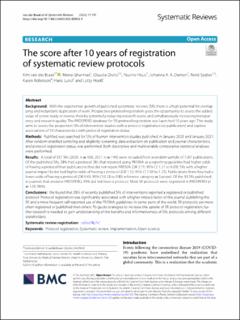| dc.contributor.author | van der Braak, Kim | |
| dc.contributor.author | Ghannad, Mona | |
| dc.contributor.author | Orelio, Claudia | |
| dc.contributor.author | Heus, Pauline | |
| dc.contributor.author | Damen, Johanna A. A. | |
| dc.contributor.author | Spijker, René | |
| dc.contributor.author | Robinson, Karen | |
| dc.contributor.author | Lund, Hans Aage | |
| dc.contributor.author | Hooft, Lotty | |
| dc.date.accessioned | 2023-03-16T11:35:43Z | |
| dc.date.available | 2023-03-16T11:35:43Z | |
| dc.date.created | 2022-10-19T11:49:50Z | |
| dc.date.issued | 2022 | |
| dc.identifier.citation | Systematic Reviews. 2022, 11 (1), . | en_US |
| dc.identifier.issn | 2046-4053 | |
| dc.identifier.uri | https://hdl.handle.net/11250/3058737 | |
| dc.description.abstract | Background
With the exponential growth of published systematic reviews (SR), there is a high potential for overlapping and redundant duplication of work. Prospective protocol registration gives the opportunity to assess the added value of a new study or review, thereby potentially reducing research waste and simultaneously increasing transparency and research quality. The PROSPERO database for SR protocol registration was launched 10 years ago. This study aims to assess the proportion SRs of intervention studies with a protocol registration (or publication) and explore associations of SR characteristics with protocol registration status.
Methods
PubMed was searched for SRs of human intervention studies published in January 2020 and January 2021. After random-stratified sampling and eligibility screening, data extraction on publication and journal characteristics, and protocol registration status, was performed. Both descriptive and multivariable comparative statistical analyses were performed.
Results
A total of 357 SRs (2020: n = 163; 2021: n = 194) were included from a random sample of 1267 publications. Of the published SRs, 38% had a protocol. SRs that reported using PRISMA as a reporting guideline had higher odds of having a protocol than publications that did not report PRISMA (OR 2.71; 95% CI: 1.21 to 6.09). SRs with a higher journal impact factor had higher odds of having a protocol (OR 1.12; 95% CI 1.04 to 1.25). Publications from Asia had a lower odds of having a protocol (OR 0.43; 95% CI 0.23 to 0.80, reference category = Europe). Of the 33 SRs published in journals that endorse PROSPERO, 45% did not have a protocol. Most SR protocols were registered in PROSPERO (n = 129; 96%).
Conclusions
We found that 38% of recently published SRs of interventions reported a registered or published protocol. Protocol registration was significantly associated with a higher impact factor of the journal publishing the SR and a more frequent self-reported use of the PRISMA guidelines. In some parts of the world, SR protocols are more often registered or published than others. To guide strategies to increase the uptake of SR protocol registration, further research is needed to gain understanding of the benefits and informativeness of SRs protocols among different stakeholders. | en_US |
| dc.language.iso | eng | en_US |
| dc.publisher | BioMed Central | en_US |
| dc.rights | Navngivelse 4.0 Internasjonal | * |
| dc.rights.uri | http://creativecommons.org/licenses/by/4.0/deed.no | * |
| dc.title | The score after 10 years of registration of systematic review protocols | en_US |
| dc.type | Peer reviewed | en_US |
| dc.type | Journal article | en_US |
| dc.description.version | publishedVersion | en_US |
| dc.rights.holder | © The Author(s) 2022 | en_US |
| dc.source.pagenumber | 10 | en_US |
| dc.source.volume | 11 | en_US |
| dc.source.journal | Systematic Reviews | en_US |
| dc.source.issue | 1 | en_US |
| dc.identifier.doi | 10.1186/s13643-022-02053-9 | |
| dc.identifier.cristin | 2062720 | |
| cristin.ispublished | true | |
| cristin.fulltext | original | |
| cristin.qualitycode | 1 | |

